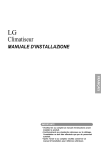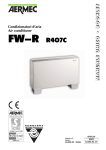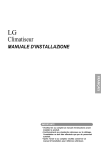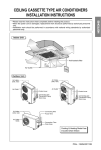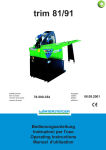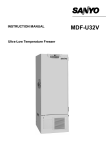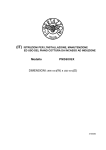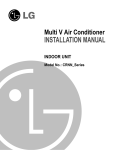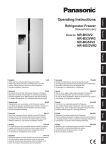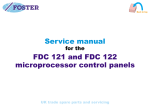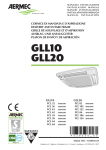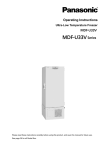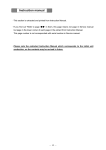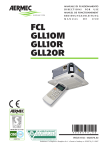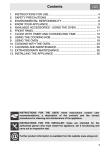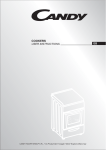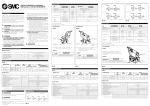Download CXE - EXE
Transcript
ISO 9001 - Cert. nº 0128/1 C RT IFI E D E A IT T EM QU L Y SY AERMEC S.P.A. S Sostituisce il: Replace: ICXE_EXEIW 0312 5986100_00 ENGLISH ITALIANO CXE - EXE M MA AN NU UA ALLEE D D’’IIN NS STTA ALLLLA AZ ZIIO ON NEE • IIN NS STTA ALLLLA ATTIIO ON N B BO OO OK KLLEETT Condizionatori d’ambiente e pompe di calore a due sezioni Split system room air conditioners and heat pumps • This unit is charged with new refrigerant, R-407C. • Be sure to use proper tools for R-407C, when installing the unit. • Please read this instruction sheet completely before installing the product. • When the power cord is damaged, replacement work shall be performed by authorized personnel only. • Installation work must be performed in accordance with the national wiring standards by authorized personnel only. Indoor Unit Air outlet vents Air filters Air intake vents Remote Controller Outdoor Unit (Side) (Rear) Air intake vents Air outlet vents Control cover (Side) Air intake vents Air outlet vents Connecting wire Piping Drain hose (Rear) Control Cover Connecting Wire Connection Pipe Drain Hose ENGLISH CEILING DUCT TYPE AIR CONDITIONERS INSTALLATION INSTRUCTIONS (Refrigerant : R-407C) OUT-LINE OF INSTALLATION 1. The following should be always observed for safety ..............................3 Installation works Installation Parts 2. Installation of Indoor, Outdoor unit 1) Selection of the best • Four Type “A” screws location............................4 • Connecting cable • Level • Screw driver • Electric drill • Hole core drill (ø70mm) 2) Indoor unit installation....5 3. Connecting Pipes to the Indoor Unit 1) Preparation of Piping...12 • Pipes: Gas side .....1/2", 5/8", 3/4" • • Liquid side .............1/4", Insulated drain hose Insulation materials Required tools • Flaring Tools set /8", 1/2" 3 4. Connecting Pipes to the Outdoor Unit 1) Connecting the pipes to • Additional Drain hose the Outdoor Unit ..........14 (Inner Dia...............25mm) 5. Checking the Drainage ..............................................................................14 6. Connecting Cables between Indoor Unit and Outdoor Unit 1) Connecting cables to the • Screw driver Indoor Unit ...................15 2) Clamping of cables ......15 3) Connecting cables to the Outdoor Unit ................16 4) Form the pipings ..........17 7. Air Purging of the Connecting Pipes and the Indoor Unit ....................18 • Hexagonal Wrench (4mm/5mm) • Gas-leak Detector 8. Group Control ............................................................................................19 9. Two Thermistor System ............................................................................19 10. Hight-Static Motor Connection(For 48K/60K Model) ............................20 11. E.S.P (External Static Pressure) Setting................................................21 12. How to set E.S.P?. ...................................................................................22 2 1. The following should be always observed for safety WARNING Could lead to death, serious injury, etc. CAUTION Could lead to serious injury in particular environments when operated incorrectly. • After reading this manual, be sure to keep it together with the owner's manual in an accessible place. WARNING Perform the installation securely referring to the installation manual. Do not install it yourself (customer). • Incomplete installation could cause injury due to fire, electric shock, the unit falling or a leakage of water. Consult the dealer from whom you purchased the unit or special installer. • Incomplete installation could cause a personal injury due to fire, electric shock, the unit falling or a leakage of water. Install the unit securely in a place which can bear the weight of the unit. Perform electrical work according to the installation manual and be sure to use an exclusive circuit. • When installed in an insufficient strong place, the unit could fall causing injured. • If the capacity of the power circuit is insufficient or there is incomplete electrical work, it could result in a fire or an electric shock. Use the specified wires to connect the indoor and the outdoor units securely and attach the wires firmly to the terminal board connecting sections so the stress of the wires is not applied to the sections. Attach the electrical part cover to the indoor unit and the service panel to the outdoor unit securely. • If the electrical part cover if the indoor unit and/or the service panel if the outdoor unit are not attached securely, it could result in a fire or electric shock due to dust, water, etc. • Incomplete connecting and fixing could cause fire. Be sure to use the part provided or specified parts for the installation work. Check that the refrigerant gas do not leak after installation is completed. • The use of defective parts could cause an injury or leakage of water due to a fire, electric shock, the unit falling, etc. CAUTION Perform the drainage/piping work securely according to the installation manual. Do not install the unit in a place where an inflammable gas leaks. • If there is a defect in the drainage/piping work, water could drop from the unit and household goods could be wet and damaged. • If gas leaks and accumulates in the area surrounding the unit, it could cause an explosion. Do not install the electric heater • Electric heater may cause deformation or fire of blower and housing which were made of plastic. 3 ENGLISH • Please report to or take consent by the supply authority before connecting to the system. • Be sure to read "THE FOLLOWING SHOULD BE ALWAYS OBSERVED FOR SAFETY" before installing the air conditioner. • Be sure to observe the cautions specified here as they include important items related to safety. • The indications and meanings are as follows. 2. Installation of Indoor, Outdoor Unit 1. Selection of the best location Inspection hole (600X600) Control box Top view 1) Indoor unit 1000 (unit: mm) Select location Install the air conditioner in the location that satisfies the following conditions. • The place shall easily bear a load exceeding four times the indoor unit’s weight. • The place shall be able to inspect the unit as the figure. • The place where the unit shall be leveled. • The place shall allow easy water drainage.(Suitable dimension “H” is necessary to get a slope to drain as figure.) • The place shall easily connect with the outdoor unit. • The place where the unit is not affected by an electrical noise. • The place where air circulation in the room will be good . • There should not be any heat source or steam near the unit 600 Front Front view H Su nro of More than 30cm Fe ob nce sta or cle s More than 30cm More than 70cm 2) Outdoor unit • If an awning is built over the unit to prevent direct sunlight or rain exposure, be careful that heat radiation from the condenser is not restricted. • There should not be any animals or plants which could be affected by hot air discharged. • Ensure the spaces indicated by arrows from the wall, ceiling, fence or other obstacles. Su More than 30cm nro of Fe ob nce sta or cle s More than 30cm More than 70cm 3) Piping length and the elevation Capacity 18K BTU/h 24K BTU/h 36K BTU/h 48K BTU/h 60K BTU/h Pipe Size Length A(m) (Diameter: Ø) Gas Liquid Standard Max. 1/4" 50 7.5 5/8" 1/4" 50 7.5 5/8" 1/4" 50 7.5 5/8" 3/8" 50 7.5 3/4" 1/2" 50 7.5 3/4" Elevation B(m) Standard 5 5 5 5 5 600 Max. 30 30 30 30 30 *Additional refrigerant (g/m) 30 30 40 40 40 • If 18K Model is installed at a distance of 15m, 225g of refrigerant should be added (15-7.5) x 30g = 225g • Capacity is based on standard length and maximun allowance length is on the basis of reliability. • Improper refrigerant charge may result in abnormal cycle. 4 Indoor unit A B Outdoor unit 2. Indoor unit installation ENGLISH ■ Installation of Unit Install the unit above the ceiling correctly. A CASE 1 B POSITION OF SUSPENSION BOLT D C E • Apply a joint-canvas between the unit and duct to absorb unnecessary vibration. • Apply a filter Accessory at air return hole. (Unit:mm) F (G) 18K BTU/h 24K BTU/h 36K BTU/h 48K BTU/h 60K BTU/h A B C D E 932 932 1232 1292 1292 880 880 1182 1230 1230 355 355 355 570.5 570.5 45.5 45.5 45.5 54 54 450 450 450 680 680 F (G) 30 30 30 30 30 87 87 87 120 120 H I 750 750 830 1006 1006 163 163 186 294 294 H 1-3 mm Capacity I Dimension Drainage hole CASE 2 M10 Nut X4 (Local M10 SP. washer X 4 supply) M10 washer X4 • Install the unit leaning to a drainage hole side as a figure for easy water drainage. M10 washer X4 (Local M10 SP. washer X 4 supply) M10 Nut X4 POSITION OF CONSOLE BOLT • A place where the unit will be leveled and that can support the weight of the unit. • A place where the unit can withstand its vibration. • A place where service can be easily performed. 5 • Select and mark the position for fixing bolts. • Drill the hole for set anchor on the face of ceiling. • Insert the set anchor and washer onto the suspension bolts for locking the suspension bolts on the ceiling. • Mount the suspension bolts to the set anchor firmly. • Secure the installation plates onto the suspension bolts (adjust level roughly) using nuts, washers and spring washers. Old building New building 1 Set anchor 2 Plate washer 3 Spring washer 4 Nut 5 Suspension bolts • Local supply Set anchor Plate washer Spring washer Nut Suspension bolt CAUTION Tighten the nut and bolt to prevent unit falling 6 - M10 - M10 - W3/8 or M10 - W3/8 or M10 CAUTION Front of view • The unit must be horizontal or declined to the drain hose connected when finished installation. 1~3mm Ceiling CORRECT INCORRECT Drainage hole CAUTION FOR GRADIENT OF UNIT AND DRAIN PIPING Drainage hole Lay the drain hose with a downward inclination so water will drain out. Thermal insulator (Local supply) • Always lay the drain with downward inclination (1/50 to 1/100). Prevent any upward flow or reverse flow in any part. • 5mm or thicker formed thermal insulator shall always be provided for the drain pipe. Drainage pipe (Local supply) Unit Make sure to be closed. Drainage hole • Upward routing not allowed CORRECT INCORRECT Applied U-Trap Dimension A ≥ 70mm B ≥ 2C C ≥ 2 x SP SP = External Pressure (mmAq) Ex) External Pressure = 10mmAq A ≥ 70mm B ≥ 40mm C ≥ 20mm • Install the P-Trap (or U-Trap) to prevent a water leakage caused by the blocking of intake air filter. 7 B C U-Trap A ENGLISH 1. Install declination of the indoor unit is very important for the drain of the duct type air conditioner. 2. Minimum thickness of the insulation for the connecting pipe shall be 5mm. • Drill the piping hole with 70mm dia, hole core drill. • Piping hole should be slightly slant to the outdoor side. WALL Indoor Outdoor 5~7mm INSULATION, OTHERS THERMAL INSULATION Insulate the joint and tubes completely. All thermal insulation must comply with local requirement. INDOOR UNIT Union for liquid pipe Thermal insulator for refrigerant pipe (Local supply) Thermal insulator for piping(Local supply) Refrigerant pipe and thermal insulator(Local supply) Hose clip for thermal insulator (Local supply) Overlap with thermal insulator for piping. Hose clip for thermal insulator(Local supply) Make sure that there is no clearance here. Thermal insulator for refrigerant pipe (Local supply) Union for gas pipe REFRIGERANT PIPE • Insulate and tape both the gas piping and liquid piping. Power cable Liquid pipe Tape Gas pipe Thermal insulator TEST AND CHECK ■ After all workings are finished, check the working and operation. • Air distribution • Drain • Gas leakage • Wiring • Lock-bolt Is the air circulation good? Is the drainage smoothly and no sweating? Is the piping connection correctly? Is the wiring connection correctly? Is the lock-bolt of compressor loosened? 8 INSTALLATION OF REMOTE CONTROL BOX Install the remote control box and cord correctly. • Although the room temperature sensor is in the indoor unit, the remote control box should be installed in such places away from direct sunlight and high humidity. INSTALLATION OF THE REMOTE CONTROL BOX ROUTING OF THE REMOTE CONTROL CORD • Select places that is not splashed by water. • Select control position after receiving customer approval. • The room temperature sensor of the thermostat for temperature control is built in the indoor unit. • This remote controller equipped with liquid crystal display. If this position is higher or lower, display is difficult to see. (The standard height is 1.2~1.5m high) • Keep the remote control cord away from the refrigerant piping and the drain piping. • To protect the remote control cord from electrical noise, place the cord at least 5cm away from other power cables. (Audio equipment, Television set, etc) • If the remote control cord is secured to a wall, provide a trap at the top of the cord to prevent water droplets from running. ELECTRICAL WIRING TO THE INDOOR UNIT Remote controller (Main board) CN REMO CN REMO Make sure that wire and terminal numbers are matched on unit side and remote controller side. The maximum length of the cord is 100m. If the length of the cord exceeds 50m, use a wire size greater than 0.5mm2. WHEN THE REMOTE CONTROL BOX IS INSTALLED WITH THE CORD EXPOSED. DISASSEMBLING OF THE REMOTE CONTROLLER Th Front case e lo we Lever carefully the box open using a screw driver, etc. rp PROCEDURE OF INSTALLATION 1. Fix the under plate on the wall by self tapping screws (accessory). 2. Make a slit (Part A) at the top side of the remote control box by nipper. 3.Rout the cord as shown in the following figure. In this case, push the cord into the around of case(Part B). 4. Hook the remote control unit on the under plate. art Remote control box body WHEN THE REMOTE CONTROL BOX IS INSTALLED WITH THE CORD BURIED. PROCEDURE OF INSTALLATION 1. Fix the under plate on the switch box by screws(Local supply). In this case, fit the under plate on the wall, and be careful of deformation. 2. Receive the remote control cord in the switch box. 3. Hook the remote control unit on the under plate. Remote control cord (Part A) Face of wall Upper notch Under plate Tapping screw (Local supply) Upper flange Push hand (Part B) Remote control unit Face of wall Upper notch Under plate Remote control unit Screw (Local supply) Remote control cord Lower notch Switch box (Local supply) Lower notch FIXING OF REMOTE CONTROL CORD 1. Fix the cord clamps on the wall by ø3 tapping screws(Local supply). 2. Fix the remote control cord. Cord clamp CAUTION Display temperature can be different from actual room temperature if the remote controller is installed at the place where sun-rays are falling directly or the place nearby heat source. To narrow the gab between display temperature and actual room temp. install the remote controller at proper place away from heat source. 9 ENGLISH POINT OF REMOTE CONTROLLER INSTALLATION REFRIGERANT PIPING Perform the work according to the Service Manual or Installation Guide. • Use two spanners when connect the refrigerant pipe to the unit. • Make a bend with a radius as large as possible. • After completing the piping connection, execute vacuum drying for the connecting piping and the indoor unit. • The vacuum drying must be carried out using the service ports of both the liquid and gas side valves. • When piping work is finished, check all joints. Flared connection (Union) Use a seemliness tube Indoor Factory charged ■ Add refrigerant if piping is over 7.5m. Capacity Addition volume 18K BTU/h 30 g/m 24K BTU/h 30 g/m 36K BTU/h 40 g/m 48K BTU/h 40 g/m 60K BTU/h 50 g/m Flared connection (Service valve, Ball valve) Outdoor INSTALLATION OF OUT DOOR UNIT ■ Select the following location • A place where the air conditioner can get good ventilation. • A place where it shall not annoy the neighbors. • A place where the unit shall be leveled and that can support the weight of unit and withstand its vibrations. Select a location that satisfies the following conditions. Install the unit firmly in place. Above 30Cm Outdoor unit Above 30Cm Above 70Cm Above 50Cm Face of wall ■ Keep a maintenance space 10 ELECTRICAL WIRING Perform the electrical wiring work according to the electrical wiring connection. Circuit Breaker Main power source Outdoor Indoor Control terminal board • Capacity of circuit breaker Control box Capacity 18K BTU/h 24K BTU/h 36K BTU/h 48K BTU/h 60K BTU/h 1 Phase 20A 25A 35A - Switch box 3 Phase 25A 25A 25A A A view Remote control cord Cord clamper 1 Connection cord between the indoor unit and the outdoor unit 1 WIRING CONNECTION Control box cover (On which the Electric Wiring Connection is put) INDOOR UNIT • Remove the control box cover for electrical connection between the indoor and outdoor unit. (Remove crews ➀.) • Use the cord clamper to fix the cord. Cord clamper Cover control OUTDOOR UNIT Main terminal board Control terminal board • Remove the control cover for wiring connection. • Use the cord clamper to fix the cord. • Earthing work Connect the cable of diameter 1.6mm2 or more to the earthing terminal provided in the control box and do earthing. Main terminal board Control terminal board Please check !! Cover control Cord clamper 11 ENGLISH • All wiring must comply with local requirements. • Select a power source that is capable of supplying the current required by the air conditioner. • Use a recognized circuit breaker between the power source and the unit. A disconnection device to adequately disconnect all supply lines must be fitted. 3. Connecting Pipes to the Indoor Unit 3-1. Preparation of Piping Main cause of gas leakage is defect in flaring work. Carry out correct flaring work in the following procedure. Copper tube Slanted Uneven Rough 90° 1) Cut the pipes and the cable. ■ Use the accessory piping kit or the pipes purchased locally. ■ Measure the distance between the indoor and the outdoor unit. ■ Cut the pipes a little longer than measured distance. ■ Cut the cable 1.5m longer than the pipe length. Pipe Reamer Point down 2) Burrs removal ■ Completely remove all burrs from the cut cross section of pipe/tube. ■ Put the end of the copper tube/pipe to downward direction as you remove burrs in order to avoid to let burrs drop in the tubing. Flare nut Copper tube 3) Putting nut on ■ Remove flare nuts attached to indoor and outdoor units, than put them on pipe/tube having completed burr removal. (Not possible to put them on after flaring work) Handle 4) Flaring work ■ Carry out flaring work using flaring tool as shown below. Outside Diameter 1/4" 3/8" 1/2" 5/8" 3/4" "A" 0~0.5 0.5~0.8 0.5~0.8 0.8~1.0 1.0~1.3 Bar Bar "A" Yoke Cone Copper pipe Clamp handle Red arrow mark Smooth all round Inside is shining without scratches. Firmly hold copper tube in a bar(or die) as indicated dimension in the table above. = Improper flaring = 5) Check ■ Compare the flared work with figure. ■ If flare is noted to be defective, cut off the flared section and do flaring work again. Even length all round 12 Inclined Surface Cracked Uneven damaged thickness 6) Pipe bending 7) Brazing In refrigerant piping, bending (in particular, acute bending) must be minimized to reduce piping resistance. Bending is, however, necessary in some places by virtue of the installation position of devices auxiliary to the packaged air conditioner, or of the building structure, piping distance or finishing appearance. If a more acute bend is required than that attainable by pipe bender, perform brazing using ready-made elbow. Aside from this function, brazing also serves to connect straight pipes, generally using ready-made sockets. While brazing, protect piping against heat with wet cloth to avoid damaging valve packing or burning thermal insulator with burner heat. While brazing, blow inert gas (nitrogen gas or carbonic gas) to prevent formation of oxidation film in copper piping; otherwise, the refrigerant circuit will clog. The blowing of nitrogen gas (or carbonic gas) through 3-way valves is described in the following: 8) Refrigerant piping(Flare piping) When connecting piping, be sure to keep piping dry(keep piping away from water), clean (keep piping away from dust) and airtight (avoid refrigerant leakage). When connecting piping on rainy days or making a through-hole in wall, take due care to prevent water or plaster from entering piping. CAUTION a. This procedure is designed to prevent formation of oxidation film by filling piping with inert gas. Note that excessive gas pressure will generate pinholes at brazed points. (Nitrogen gas: Supply pressure 0.05~0.1kg/cm2G) b. When supplying inert gas, be sure to open one end of piping. Water enters 13 Plaster enters ENGLISH Annealed copper pipe with small diameter (ø6.35 or ø9.52) can be easily bent manually. In this case, secure large R(radius) for the bend section and gradually bend pipe. If annealed copper pipe is large in diameter (ø15.88 or ø19.05), bend pipe with bender. Use bender appropriate for the pipe diameter. 4. Connecting Pipes to the Outdoor Unit 1) Connecting the pipes to the Outdoor unit 1. Align the center of the pipings and sufficiently tighten the flare nut with fingers. 2. Finally, tighten the flare nut with torque wrench until the wrench clicks. • When tightening the flare nut with torque wrench, ensure the direction for tightening follows the arrow on the wrench. Pipe size Torque 1/4" 1.8kg.m 3/8" 4.2kg.m 1/2" 5.5kg.m 5/8" 6.6kg.m 3/4" 6.6kg.m Outdoor unit Gas side piping (Bigger Dia.) Liquid side piping (Smaller Dia.) Torque wrench 5. Checking the Drainage 1) Checking the Drainage 1. Remove the Air Filter. 2. Check the drainage. • Spray one or two glasses of water upon the evaporator. • Ensure that water flows drain hose of indoor unit without any leakage. 14 6. Connecting Cables between Indoor Unit and Outdoor Unit ■ Connect the wires to the terminals on the control board individually according to the outdoor unit connection. • Ensure that the color of the wires of outdoor unit and the terminal No. are the same as those of indoor unit respectively ■ 18K/24K Btu • Cooling only type (380-415V3N~) (220-240V~) Terminals on the indoor unit 3(L) 4(N) Terminals on the outdoor unit 1(L) 2(N) 3(L) 4(N) 5 5 6 1(L) R 2(N) T N POWER INPUT POWER INPUT POWER INPUT S • Cooling & Heating type Terminals on the indoor unit 3(L) 4(N) 5 6 7 Terminals on the outdoor unit 1(L) 2(N) 3(L) 4(N) 5 6 7 8 POWER INPUT ■ 36K Btu ■ 48K/60K Btu • Cooling only type • Cooling only type Terminals on the indoor unit 1 2 3 4 5 Terminals on the indoor unit 1(L) 2(N) 3 4 5 Terminals on the outdoor unit 1 2 3 4 5 Terminals on the outdoor unit 1(L) 2(N) 3 4 5 • Cooling & Heating type • Cooling & Heating type Terminals on the indoor unit 1 2 3 4 5 Terminals on the indoor unit 1(L) 2(N) 3 4 5 Terminals on the outdoor unit 1 2 3 4 5 Terminals on the outdoor unit 1(L) 2(N) 3 4 5 CAUTION The power cord connected to the outdoor unit should be The connecting cable connected to the indoor and outdoor complied with the following specifications (Rubber unit should be complied with the following specifications insulation, type H05RN-F approved by HAR or SAA). (Rubber insulation, type H05RN-F approved by HAR or SAA). NORMAL CROSS-SECTIONAL AREA GN /YL 20 mm Capacity 1 Phase 3 Phase 18K BTU/h 2.5mm2 - 24K BTU/h 2.5mm2 - 36K BTU/h 5.5mm2 2.5mm2 48K BTU/h - 3.5mm2 60K BTU/h - 3.5mm2 NORMAL CROSS-SECTIONAL AREA 0.75mm2 (18K/24K) 1.25mm2 (36K/48K/60K) GN /YL 20 mm If the supply cord is damaged, it must be replaced by a special cord or assembly availible from the manufacturer of its service agent. WARNING Make sure that the screws of the terminal are free from looseness. 2) Clamping of cables 1) Arrange 2 power cables on the control panel. 2) First, fasten the steel clamp with a screw to the inner boss of control panel. 3) For the cooling model, fix the other side of the clamp with a screw strongly. For the heat pump model, put the 0.75mm2 cable(thinner cable) on the clamp and tighten it with a plastic clamp to the other boss of the control panel. 4) In Australia, the length of power supply cord measured from the entry of the power supply cord to the middle of live pin on the power plug should be over 1.8m. 15 ENGLISH 1) Connecting cables to the Indoor Unit 3) Connecting the cable to the Outdoor Unit Outdoor unit 1. Remove the Cover control from the unit by loosening a screw. Connect the wires to the terminals on the control board individually as following. Terminal block Cord Clamper 2. Secure the cable onto the control board with the holder (clamper). Over 5mm 3. Refix the cover control to the original position with the screw. Cover control Power supply cord Outdoor unit Terminal block Cord Clamper Power supply cord Over 5mm Cover control CAUTION After the confirmation of the above conditions, prepare the wiring as follows: 1) Never fail to have an individual power specialized for the air conditioner. As for the method of wiring, be guided by the circuit diagram pasted on the inside of control box cover. 2) Provide a circuit breaker switch between power source and the unit. 3) The screw which fasten the wiring in the casing of electrical fittings are liable to come loose from vibrations to which the unit is subjected during the course of transportation. Check them and make sure that they are all tightly fastened. (If they are loose, it could give rise to burn-out of the wires.) 4) Specification of power source 5) Confirm that electrical capacity is sufficient. 6) Be sure that the starting voltage is maintained at more than 90 percent of the rated voltage marked on the name plate. 7) Confirm that the cable thickness is as specified in the power sources specification. (Particularly note the relation between cable length and thickness.) 8) Never fail to equip a leakage breaker where it is wet or moist. 9) The following troubles would be caused by voltage drop-down. • Vibration of a magnetic switch, damage on the contact point there of, fuse breaking, disturbance to the normal function of a overload protection device. • Proper starting power is not given to the compressor. 16 4) Form the pipings Seal a small opening around the pipings with gum type sealer. Drain hose Taping Pipings Connecting cable Power supply cord In case of the Outdoor unit being installed below position of the Indoor unit. 2. Tape the Pipings, drain hose and Connecting Cable from bottom to top. 3. Form the pipings gathered by taping along the exterior wall and fix it onto the wall by saddle or equivalent. Trap is required to prevent water from entering into electrical parts. Drain hose Taping Pipings Connecting cable Power supply cord In case of the Outdoor Unit being installed above position of the Indoor Unit. Seal a small opening around the pipings with gum type sealer. 2. Tape the Pipings and Connecting cable from bottom to top. Trap 3. Form the pipings gathered by taping along the exterior wall, and make the trap prevent water from entering into the room. 4. Fix the pipings onto the wall by saddle or equivalent. Trap 17 ENGLISH 1. Wrap the connecting portion of indoor unit with the Insulation material and secure it with two Plastic Bands. (for the right pipings) • If you want to connect an additional drain hose, the end of the drain-outlet should keep distance from the ground. (Do not dip it into water, and fix it on the wall to avoid swinging in the wind.) 7. Air Purging of the Connecting Pipes and the Indoor Unit The air which contains moisture remaining in the refrigeration cycle may cause a malfunction on the compressor. 1. Confirm that both the liquid side valve and the gas side valve are set to the closed position. 2. After connecting the piping, check the joints for gas leakage with gas leak detector. 3. Remove the service port nut, and connect the gauge manifold and the vacuum pump to the service port by the charge hose. 4. Vacuum the indoor unit and the connecting pipes until the pressure in them lowers to below 76cmHg. 5. Remove the valve stem nuts, and fully open the stems of the 2-way and 3-way valves with a hexagon wrench. 6. Tighten the valve stem nuts of the 2-way valve and 3-way valve. 7. Disconnect the charge hose and fit the nut to the service port. (Tightening torque: 1.8kg.m) Indoor unit Liquid side Closed Outdoor unit 2-way valve/ 3-way valve Gas side 3-way valve Vaccum pump OPEN CLOSE 18 Closed 8. Group Control Main PCB Indoor Unit 1 Indoor Unit 2 Terminal(Local Supply) Block Connector Terminal(Local Supply) Block Connector RED(12V) YL(SIGNAL) BR(GND) RED(12V) YL(SIGNAL) BR(GND) Main PCB #1 YL(SIGNAL) BR(GND) Indoor Unit 16 Terminal(Local Supply) Block Connector Main PCB #2 YL(SIGNAL) BR(GND) .... OPERATION SET TEMP Room Temp Operation unit 03 FAN SPEED HI MED LO Time Timer On Off Set no. Time 01 ZONE YL(SIGNAL) BR(GND) Main PCB #16 Connecting Cable(Local Supply) .... AUTO SWING YL(SIGNAL) BR(GND) SUB FUNCTION AUTO Heater Preheat JET Defrost Humidify Filter Out door 1 2 3 4 Program set 05 07 09 11 13 15 17 19 21 23 Wired Remote Controller (Standard) Slide Switch2 Single Group Remote Controller PCB • Using the supplied Wired Remote Controller, wire them like above. • Move slide switch 2 to "Group" position. • Ensure that the color of wire. 9. Two Thermistor system • Open the rear cover of Remote Controller to set up the mode. Slide Switch1 Slide Switch2 Room Temp. Sensing Remo. Indoor Unit 2 TH(Remo.+Indoor) • Selectable options are three as follows. - Remo: Sensing the room Temperature. - Indoor Unit: Sensing the intake air into indoor Unit. - 2 TH: Sensing the lower temperature of the two thermistors. Single Group CAUTION • On installing, don't impact to the PCB and LCD display. • Don't remove the protection sheet. • Use the specified screw. • On installing, turn off the main power. • To set up the mode, adjust the slide switch to desired mode position on installing. 19 ENGLISH It operates maximum 16 Units by only one Wired Remote Controller, and each Unit starts sequentially to prevent overcurrent. 10. High-Static Motor Connection (For 48K/60K Model) 1. High-Static Motor Connection (For 48K Model) Control box • If working condition of indoor unit is higher than that of standard static pressure (10mmAq) change the Indoor Motor wire housing for standard motor housing for higher external static Pressure (15mmAq). Wire Color(YL, BK, BL, OR) For Higher E.S.P(15mmAq) Wire Color(BK, BL, RD, OR) For Standard E.S.P(10mmAq) 2. Motor Connection (For 60K Model) Control box • If working condition of indoor unit is lower than that of standard static pressure (10mmAq) change the Indoor Motor wire housing for standard motor housing for lower external static Pressure (6mmAq). Wire Color(YL, BK, BL, OR) For Standard E.S.P(10mmAq) Wire Color(BK, BL, RD, OR) For Lower E.S.P(6mmAq) 20 11. E.S.P.(External Static Pressure) Setting ENGLISH (1) Open the rear cover of the wired remote-controller to set the mode. (2) Select one of three selectable modes as follows. ■ Without Zone System 1. Position V-H, F-H: • This position sets the maximum E.S.P as a default set. 2. Position V-L: • This position sets the minimum E.S.P as a default set. ■ With Zone System 1. Position V-H: • Maximum E.S.P setting & Fan speed is varied according to the state of dampers by micom. 2. Position F-H: • Maximum E.S.P setting & Fan speed doesn't vary according to the opening & Closing of dampers. 3. Position V-L: • Minimum E.S.P setting & Fan speed is varied according to the state of dampers by micom. * Maximum : 18K-8mmAq 24K-6mmAq 36K-8mmAq 48K-15mmAq 60K-15mmAq Minimum : 0mmAq (3) Move the slide switch to set position. TH R14H OP3 SW TH V-L R13H OP2 REMO MAIN 2TH R12H CO1H OP1 R19H R11H OP7 R18H R17H F-H OP6 LO STAND C070 V-H R03S HI R04S Slide switch for ceiling height (4) Close the rear cover and check if it works normally. CAUTION • Select the position after checking duct work and E.S.P of the unit. • Maunfactured in the position F-H. 21 HIGH R02S SW R01S OP5R16H OP4 R15H 12. How to Set E.S.P? Procedure of RPM change: Ex) External Static pressure is 6mmAq for Model Name "LB-H1860 * * " • To protect the unit, compressor is designed to be off during E.S.P. setting. 1 Push the "On/Off" button. The unit will start. AUTO SWING OPERATION SET TEMP FAN SPEED Room Temp AUTO Heater Preheat JET Defrost Humidify Filter Out door ZONE 1 2 3 4 Time Timer Operation unit On Off Set no. Time 01 2 03 Program set 05 07 09 11 13 15 17 19 21 23 Push the "Timer" and "Wind" button simultaneously for more then 3 seconds. AUTO SWING Timer OPERATION SET TEMP Room Temp FAN SPEED Operation unit 03 SUB FUNCTION HI MED LO AUTO Heater Preheat JET Defrost Humidify Filter Out door ZONE 1 2 3 4 Time Timer On Off Set no. Time 01 3 SUB FUNCTION HI MED LO Program set 05 07 09 11 13 15 17 19 21 23 Push the "Up" of "Down" button for E.S.P adjustment. And, adjust the number which you want.(In this example, the number is "215". Refer to the table 1 on the next page.) AUTO SWING OPERATION SET TEMP Room Temp FAN SPEED AUTO Heater Preheat JET Defrost Humidify Filter Out door ZONE 1 2 3 4 Time Timer Operation unit On Off Set no. Time 01 03 SUB FUNCTION HI MED LO Program set 05 07 09 11 13 15 17 19 21 23 Note: The range of selection is from 1~254. Since, the display is two Digit only. If the range selection is above 100 then the third digit will appear in the screen as shown. 4 Shift the fan speed mode by pressing the fan speed button. And then, Adjust numbers of next steps by repeating the stage 3. (In this example, the numbers are "230" and "245" respectly) 5 Push the "Timer" and "Wind" button simultaneously for more than 3 seconds. Then, Wind Data is memorized by the EEPROM of the main PCB. AUTO SWING OPERATION SET TEMP Room Temp AUTO Heater Preheat JET Defrost Humidify Filter Out door ZONE 1 2 3 4 Time Timer Operation unit 22 03 SUB FUNCTION HI MED LO Timer On Off Set no. Time 01 FAN SPEED Program set 05 07 09 11 13 15 17 19 21 23 Static Pressure(mmAq) 0 2 Model Name Step(Hi/Med/Lo) EXE180H EXE240H 4 6 8 10 Setting Value 16.5 CMM 235 230 225 215 180 14.5 CMM 245 238 235 230 215 13 CMM 254 252 248 245 240 18 CMM 230 215 210 50 - 16.5 CMM 240 235 230 210 - 14 CMM 255 252 250 245 - 32 CMM 235 230 230 150 1 29 CMM 247 245 245 235 230 26.5 CMM 254 253 253 250 248 EXE360H Note: 1. Be sure to set the value refering table 1. Unexpected set value will cause mal-function. 2. Table 1 is based at 230V. According to the fluctuation of voltage, air flow rate varies. [Table. 2] Static Pressure(mm Aq) Model Name EXE480H EXE600H (Standard) EXE600H (Low Static) 0 2 4 6 8 10 15 Step CMM CMM CMM CMM CMM CMM CMM High 48.5 46.5 45 43.5 42 40 40 Med 43 41.5 39.5 38 36.5 35 35 Low 39 37.5 36 34.5 33 31 30 High 58.5 57 55 53 51 49 44 Med 54 52.5 51 49 47 45 39 34 Low 49 47.5 46 44 42 40 High 54 52.5 51 49 47 45 Med 49 47.5 46 44 42 40 Low 44 42.5 41 39 37 35 1) The above table shows the correlation of External Static Pressure & AIR FLOW. 2) Duct work must be designed within the range of on installing the unit. 3) Change the wiring diagram referring to page 20 of manual on condition fo High/Low Static Pressure. 4) If duct work is designed under Pressure applying air damper. External Static Pressure, adjust the External Static 23 ENGLISH [Table. 1] Memo 24 INSTRUZIONI PER I'INSTALLAZIONE DEL CONDIZIONATORE D'ARIA DI TIPO DA CONTROSOFFITTO A SCOMPARSA (Refrigerante: R-407C) Gruppo Interno Prese d’aria di uscita Filtri aria Prese d’aria di entrata Pannellino comandi Gruppo Esterno ( Lato) (Retro) Prese d’aria di entrata Prese d’aria di uscita Coperchio di controllo ( Lato) Cavo di collegamento Condutture Tubo flessibile di scarico (Retro) Prese d’aria di entrata Prese d’aria di uscita Coperchio di controllo Cavo di collegamento Condutture Tubo flessibile di scarico ITALIANO • Unità con gas refrigerante R407C. • In fase di installazione usare strumenti adatti per R407C. • Si raccomanda di leggere completamente queste istruzioni prima di procedere con l’installazione del prodotto. • Nel caso fosse necessario sostituire il cavo di alimentazione, la sostituzione deve essere effettuata solamente da personale autorizzato. • Il lavoro di installazione deve essere effettuato in conformità agli standard nazionali relativi agli impianti elettrici e solamente da personale autorizzato. SCHEMA DI INSTALLAZIONE 1. Per la sicurezza è necessario osservare sempre quanto segue ............3 Lavori di installazione Componenti dell’installazione Arnesi richiesti 2. Installazione dei gruppi Interno e Esterno 1) Selezione della posizione migliore ..........................4 2) Installazione del gruppo interno............................5 • Quattro viti di tipo “A” • Cavo di collegamento • Livella • Cacciavite • Trapano • Punta trapano (D. 70mm) 3. Collegamento dei Tubi al Gruppo Interno 1) Preparazione delle tubature. ......................12 • Tubi: lato gas..........1/2", 5/8", 3/4" Lato liquido ...........1/4", 3/8", 1/2" • Tubo flessibile di scarico isolato • Materiali di isolamento • Corredo arnesi per la svasatura 4. Collegamento dei Tubi al Gruppo Esterno 1) Collegamento dei tubi al Gruppo Esterno ...........14 • Tubo flessibile di scarico addizionale (Diametro Interno..25mm) 5. Controllo dello scarico ..............................................................................14 6. Collegamento dei cavi tra Gruppo interno ed esterno • Cacciavite 1) Collegamento dei cavi al Gruppo Interno ............15 2) Bloccaggio dei Cavi .....15 3) Collegamento dei cavi al Gruppo Esterno ...........16 4) Sagomatura dei tubi.....17 7. Spurgo dei Tubi di Collegamento e del Gruppo Interno ........................18 • chiave esagonale (4mm, 5mm) • Rilevatore di fughe di gas 8. Controllo di gruppo ..................................................................................19 9. Il sistema a due termistori ........................................................................19 10. Connessione motore per alta pressione statica (solo modelli EXE480H/600H)....20 11. Come impostare la P.S.E(Pressione Statica Esterna) .........................21 12. Impostazione P.S.E ? ...............................................................................22 2 1. Per la sicurezza è necessario osservare sempre quanto segue • Rispettare le normative vigenti. • Osservare attentamente le avvertenze specificate in questo documento poichè includono elementi importanti relativi alla sicurezza. • I significati delle indicazioni: ATTENZIONE Può portare a lesioni gravi, morte ecc. Può portare a lesioni gravi in ambienti particolari se utilizzati in modo improprio. • Dopo aver letto questo manuale, conservarlo sempre insieme al libretto di istruzioni in un posto facilmente accessibile. PERICOLO Effettuare l’installazione seguendo tutti i parametri di sicurezza facendo riferimento al manuale di installazione. Non installare da soli (cliente) • Una installazione incompleta può causare lesioni gravi a causa di incendi, scossa elettrica, caduta del gruppo o perdite di acqua. Consultare il rivenditore dal quale avete acquistato il gruppo o un installatore specializzato. • Una installazione incompleta può provocare lesioni personali gravi in seguito ad incendi, scosse elettriche, caduta del gruppo o perdite di acqua. Installare saldamente il gruppo in un punto che può sostenere il peso del gruppo Effettuare i lavori sull’impianto elettrico facendo riferimento al manuale di installazione ed assicurare l’uso di un circuito esclusivo. • Se viene installato in un punto che non è sufficientemente forte il gruppo può cadere causando lesioni. • Se la portata del circuito elettrico è insufficiente o l’impianto elettrico è incompleto si possono verificare incendi o scosse elettriche. Usare i fili elettrici specificati per collegare saldamente i gruppi interno ed esterno e collegare bene i cavi alle sezioni di connessione del pannello terminale in modo che lo stress dei fili non venga applicato alle sezioni. Fissare bene il coperchio dei componenti elettrici al gruppo interno ed il pannello di servizio al gruppo esterno. • Se il coperchio del componente elettrico del gruppo interno e/o il pannello di servizio del gruppo esterno non sono ben fissati, si possono verificare incendi, scosse elettriche a causa di polvere acqua ecc. • Collegamenti o fissaggi incompleti possono provocare incendi. Usare solamente i componenti corretti forniti o i componenti specificati per il lavoro di installazione. Verificare che non ci siano fughe di gas refrigerante una volta completata I'installazione. • L’uso di componenti difettosi può provocare lesioni o perdite di acqua inseguito a incendi, scosse elettriche, caduta del gruppo ecc. ATTENZIONE Effettuare il lavoro relativo alle tubature/scarico con la massima cura seguendo le istruzioni del manuale. Non installare il gruppo in un luogo in cui ci siano fughe di gas infiammabile. • Se ci sono difetti nel lavoro di tubature/scarico, è possibile che l’acqua goccioli dal gruppo, e beni personali e mobili casa potrebbero bagnarsi ed essere irrimediabilmente danneggiati. • Se una fuga di gas si accumula nell’area circostante il gruppo si potrebbero verificare esplosioni. Non installare il riscaldamento elettrico • Il riscaldamento elettrico può provocare deformazione o incendio del ventilatore e dell'alloggiamento che sono costituiti di plastica. 3 ITALIANO PERICOLO 2. Installazione dell'unità interna ed esterna 1) Unità interna Selezione della posizione Installare il condizionatore d’aria nel punto che soddisfa le seguenti condizioni. • Il punto può facilmente sostenere quattro volte il peso del gruppo interno. • In questo punto sarà agevole ispezionare il gruppo come indicato dall’illustrazione. • Un punto in cui il gruppo sarà messo a livello. • Un punto che permetta un agevole scarico dell’acqua. (Le dimensioni idonee “H” sono necessarie per ottenere una curva per scaricare come dall’illustrazione.) • Un punto in cui sia agevole effettuare il collegamento con il gruppo esterno. • Un punto in cui il gruppo non sia influenzato da disturbi elettrici. • Un punto in cui la circolazione di aria nella stanza sia buona. • L’assenza di fonti di calore o vapore nelle vicinanze dell'unità. Foro di ispezione (600X600) Scatola di controllo 1000 Vista superiore (unità: mm) 1. Selezione della migliore posizione 600 600 Fronte Vista frontale H Ten da Oltre 30cm St ec os cato tac o oli Oltre 30cm Oltre 70cm 2) Unità esterna • Nel caso venga costruita una tenda sopra l'unità per prevenire la luce diretta del sole o l’esposizione alla pioggia assicurarsi che non venga limitata la radiazione di calore dal condensatore. • Non ci devono essere animali o piante che possano essere investiti dal calore rilasciato. • Assicurare la presenza degli spazi indicati dalle frecce dal muro, soffitto, steccato o altri ostacoli. Ten Oltre 30cm da St ec os cat tac o o oli Oltre 30cm Oltre 70cm 3) Lunghezza ed elevazione dei tubi Modello 180 240 360 480 600 Dimensioni del tubo Lunghezza A (m) Elevazione B (m) Carica (Diametro:Ø) aggiuntiva Gas Liquido Nominale Massima Nominale Massima 1/4" 30 5 50 7.5 5/8" 30 1/4" 30 5 50 7.5 5/8" 30 1/4" 30 5 50 7.5 5/8" 40 3/8" 30 5 50 7.5 3/4" 40 1/2" 30 5 50 7.5 3/4" 40 Unità interna • Se i modelli 180 vengono installati ad una distanza di 15m, sarà necessario aggiungere 225g di refrigerante (15-7.5) x 30g = 225g • La capacità si basa sulla lunghezza standard e la lurghezza massima permessa viene calcolata sulla base dell'affidabilità. • Una carica non corretta del refrigerante potrebbe causare un funzionamento anormale. 4 A B Unità esterna 2.Installazione dell'unità interna ■ Installazione dell'unità Installare correttamente sul soffitto A B CASO 1 POSIZIONE DEL BULLONE DI SOSPENSIONE F (G) Dimensioni A B C D E 932 932 1232 1292 1292 880 880 1182 1230 1230 355 355 355 570.5 570.5 45.5 45.5 45.5 54 54 450 450 450 680 680 F (G) H I 750 750 830 1006 1006 163 163 186 294 294 30 30 30 30 30 87 87 87 120 120 I 180 240 360 480 600 1-3 mm Capacità H Foro di scarico CASO 2 Dado M10 • Installare l'unità in pendenza verso il foro di scarico come indicato dalla figura per facilitare lo scarico dell’acqua. X4 Rondella Dist M10 SP X 4 (Fornitura locale) Rondella M10 X 4 Rondella M10 X 4 POSIZIONAMENTO DELL'UNITA Rondella Dist. M10 X 4 (Fornitura locale) Dado M10 X4 • Un punto dove l'unità é a livello ed il suo peso può essere sostenuto. • Un punto in cui l'unità può sopportare le vibrazioni • Un punto che sia facile da raggiungere per la manutenzione. 5 ITALIANO D C E • Applicare un giunto antivibrante tra l'unità e il canale al fine di assorbire le vibrazioni inutili. • Applicare un accessorio filtro sul foro di ritorno dell’aria (Unit:mm) • Selezionare e contrassegnare la posizione di fissaggio dei bulloni. • Praticare un foro per inserire gli ancoraggi sul soffitto. • Inserire l’ancoraggio e la rondella sui bulloni di sospensione per bloccare i bulloni di sospensione al soffitto. • Montare i bulloni di sospensione per ancorare saldamente. • Fissare le piastre di installazione sui bulloni di sospensione (regolare il livello a occhio) usando dadi, rondelle e rondelle elastiche. Costruzione vecchia Costruzione nuova 1 Ancoraggio 2 Rondella piastra 3 Rondella elastica 4 Dado 5 Bullone di sospensione • Fornitura locale: Ancoraggio Rondella piastra Rondella elastica Dado Bullone di sospensione ATTENZIONE Stringere il dado e bullone per evitare la caduta del gruppo. 6 - M10 - M10 - W3/8 or M10 - W3/8 or M10 ATTENZIONE 1. La pendenza di installazione dell'unità interna è particolarmente importante nei modelli canalizzati. 2. Lo spessore minimo dell’isolamento dei tubi di collegamento deve essere di 5 mm. Vista di fronte ITALIANO • Il gruppo deve essere orizzontale e in pendenza verso il tubo di scarico. 1~3mm SOFFITTO CORRETTO Foro di scarico SCORRETTO Foro di scarico Disporre il tubo flessibile di scarico con una inclinazione verso il basso per facilitare lo scarico dell'acqua. ATTENZIONE PER LA PENDENZA DEL TUBO DI SCARICO Isolatore termico (Fornitura locale) • Disporre sempre lo scarico con una inclinazione verso il basso (1/50 a 1/100). Gruppo Evitare percorsi ascendenti. • Il tubo di scarico deve essere sempre fornito di isolamento termico sagomato dello spessore di 5mm o superiore. Verificare che sia chiuso CORRETTO SCORRETTO Dimensioni applicate sifone a U A ≥ 70mm B ≥ 2C C ≥ 2 x SP SP = Pressione esterna (mmAq) Es) Pressione esterna = 10mmAq A ≥ 70mm B ≥ 40mm C ≥ 20mm • Installare il sifone intercettatore a P (o sifone a U) per prevenire le perdite di acqua provocate dal blocco del filtro di aspirazione. 7 Tubo di scarico (Fornitura locale) Foro di scarico • La disposizione del tubo verso l'alto non è permessa. B C Sifone a U A • Praticare un foro per i tubi con una punta di 70mm di diametro. • Il foro per la tubatura deve essere leggermente inclinato verso il basso dal lato esterno. ISOLAMENTO, E VARIE ISOLAMENTO TERMICO MURO Interno Esterno 5~7mm Isolare completamente i raccordi ed i tubi. Tutto l’isolamento termico deve essere conforme ai requisiti locali. Unità interna Isolatore termico per tubo refrigerante (fornitura locale) Isolatore termico per tubi (fornitura locale) Raccordo per tubo del liquido Tubo refrigerante e isolatore termico (fornitura locale) Morsetto per tubo flessibile per isolatore termico (fornitura locale) Isolatore termico per tubo refrigerante (fornitura locale) Parte sovrapposta con isolatore termico per tubature (Fornitura locale) Morsetto per tubo flessibile per isolatore termico (fornitura locale) Assicurarsi che non ci sia luce in questa posizione. Raccordo per tubo gas Tubo refrigerante Isolare con nastro sia le condutture del gas che le condutture del liquido. Cavo di alimentazione Tubo liquido Nastro Tubo gas Isolatore termico Prove e controlli ■ Una volta finito il lavoro, eseguire i seguenti controlli. • Distribuzione aria La circolazione dell’aria è soddisfacente? • Scarico Lo scarico è regolare e senza gocciolamenti? • Fughe di gas I collegamenti dei tubi sono corretti? • Cablaggio Le connessioni dei cavi sono corrette? • Bullone di bloccaggio Il bullone di bloccaggio del compressore è allentato? 8 INSTALLAZIONE DELLA SCATOLA DEL TELECOMANDO Installare correttamente il cavo e la scatola di controllo del telecomando. PUNTO DI INSTALLAZIONE DEL TELECOMANDO • Nonostante nell'unità interna sia presente un sensore della temperatura dell’ambiente, la scatola del telecomando deve essere installata in punti lontani dalla luce diretta del sole o di alta umidità. INSTALLAZIONE DELLA SCATOLA DEL TELECOMANDO DISPOSIZIONE DEL CAVO DEL TELECOMANDO • Tenere il cavo del telecomando lontano dalle tubature refrigeranti e le tubature di scarico. • Per schermare il cavo del telecomando da disturbi elettrici, disporre il cavo a 5 cm da altri cavi di alimentazione. (Apparecchi audio, televisore ecc.) • Se il cavo del pannellino comandi viene fissato ad un muro inserire un separatore nella sezione superiore del cavo per evitare lo sgocciolare di acqua. CABLAGGIO ELETTRICO DELL'UNITA INTERNA Pannellino comandi (Pannello principale) CN REMO CN REMO Verificare che i numeri di filo e di terminale siano combinati sul lato unità e sul lato telecomando. La lunghezza massima del cavo è 100 m. Se la lunghezza del cavo supera 50m, usare un filo con sezione superiore a 0,5mm2 NEL CASO DI INSTALLAZIONE DI SCATOLA DEL PANNELLINO COMANDI CON CAVO A VISTA SMONTAGGIO DEL PANNELLINO COMANDI Scatola frontale Se zio ne i nfe r PROCEDURE DI INSTALLAZIONE 1. Fissare la sottopiastra al muro con viti autofilettanti. 2. Praticare una fessura (Parte A) sul lato superiore della scatola pannellino comandi con una tenaglia. 3. Far passare il cavo come indicato nella figura che segue. In questo caso premere il cavo intorno alla scatola (Parte B) 4. Agganciare l’unità del telecomando sulla Parete sottopiastra ior Fare leva con attenzione usando un cacciavite per aprire la scatola e Corpo scatola del telecomando. NEL CASO DI INSTALLAZIONE DI SCATOLA DEL TELECOMANDO CON CAVO INCASSATO PROCEDURE DI INSTALLAZIONE 1. Fissare la sottopiastra sulla scatola degli interruttori con delle viti (fornitura locale). In questo caso inserire la piastra sul muro facendo attenzione a non deformarla. 2. Infilare il cavo delpannellino comandi nella scatola degli interruttori. 3. Agganciare l’unità del pannellino comandi sulla sottopiastra. Dentellatura Superiore Sottopiastra Vite autofilettante (Parte A) (Fornitura locale) Flangia superiore Premere (Parte B) Cavo del pannellino comandi Unità di Dentellatura pannellino comandi inferiore Parete Dentellatura superiore Sottopiastra FISSAGGIO DEL CAVO DEL TELECOMANDO Unità pannellino comandi Vite (fornitura locale) Morsetto per cavo 1. Fissare le reggette del cavo sul muro usando viti autofilettanti del 3ÿ (fornitura locale) 2. Fissare il cavo del pannellino comandi. Cavo del pannellino comandi Dentellatura inferiore Scatola interruttore ATTENZIONE La temperatura indicata sul display può essere differente dalla temperatura della stanza se il pannellino comandi è installato in un luogo esposto a raggi diretti del sole o vicino a una fonte di calore. Per ridurre la differenza tra la temperatura della stanza e quella indicata sul display, installare il pannellino comandi in un luogo idoneo lontano da fonti di calore. 9 ITALIANO • Selezionare punti che non siano sottoposti agli schizzi d’acqua • Selezionare una posizione per il controllo dopo avere ricevuto l’approvazione del cliente. • Il sensore della temperatura dell’ambiente del termostato per il controllo della temperatura è inserito nell'unità interna. • Il telecomando è fornito di display a cristalli liquidi. Se la posizione è troppo alta o troppo bassa il display sarà difficile da vedere. (L’altezza standard è 1,2-1,5 m di altezza) TUBATURE DEL REFRIGERANTE Effettuare il lavoro come indicato dal Manuale di servizio o di installazione. • Usare due chiavi per collegare il tubo refrigerante al gruppo. • Piegare con un raggio il più ampio possibile. • Completati i collegamenti dei tubi, eseguire il vuoto del circuito frigorifero. • La fase di vuoto del circuito frigorifero deve essere eseguita con valvole del liquido e del gas aperte. • Terminato il lavoro controllare tutte le giunture. Collegamento svasato (raccordo) Usare un tubo senza giunzioni Interno Caricato dalla fabbrica ■ Aggiungere refrigerante quando la lunghezza delle tubature supera 7.5 m. Capacità Volume da aggiungere 180 30 g/m 240 30 g/m 360 40 g/m 480 40 g/m 600 50 g/m Collegamento svasato (Valvola di servizio, valvola a sfera) Esterno INSTALLAZIONE DEL GRUPPO ESTERNO ■ Selezionare una posizione come segue • Un punto in cui il condizionatore riceva una buona ventilazione • Un punto in cui non dia fastidio ai vicini • Un punto in cui l'unità sia a livello e possa sostenere il peso che e sopportare le vibrazioni. Selezionare una posizione che soddisfi le seguenti condizioni. Installare l'unità in maniera solida e sicura. Superiore a 30Cm unità esterna Superiore a 30Cm Superiore a 70Cm Superiore a 50Cm Fronte della parete ■ Assicurare gli spazi tecnici per la manutenzione 10 IMPIANTO ELETTRICO Effettuare i lavori dell’impianto elettrico seguendo gli schemi di connessione. Capacità 180 240 360 480 600 1 Fase 20A 25A 35A - Interruttore automatico Alimentazione principale Scatola interruttori Esterno Interno Pannello terminale del cavo Vista A A Scatola di controllo 3 Fasi 25A 25A 25A Cavo pannellino comandi 1 Morsetto per cavo 1 Cavo di collegamento tra il gruppo interno e il gruppo esterno Coperchio della scatola di controllo (Su questo viene inserito il collegamento del cavo elettrico) COLLEGAMENTI ELETTRICI UNITA INTERNA • Rimuovere il coperchio della scatola di controllo tra i gruppi interno e esterno (rimuovere due viti). • Usare un morsetto per cavi per fissare il cavo. Pannello principale dei terminali Pannello terminale di controllo Morsetto per cavi Coperchio di controllo UNITA ESTERNA • Rimuovere il coperchio per effettuare il collegamento dei fili. • Usare un morsetto per cavi per fissare il cavo. • Lavoro di messa a terra. Collegare un cavo del diametro di 1,6mm2 o superiore al terminale di terra fornito sulla scatola di controllo e mettere a terra. Pannello principale dei terminali Pannello terminale di controllo Per favore verificare!! Coperchio Morsetto per cavi 11 ITALIANO • L’impianto elettrico deve essere conforme ai requisiti locali. • Selezionare una fonte di alimentazione che possa alimentare la corrente richiesta dal condizionatore d’aria. • Usare un interruttore automatico omologato tra l’alimentazione ed il gruppo. Deve essere installato anche un dispositivo di sezionamento, per scollegare in modo adeguato tutte le linee di alimentazione. • Interruttore automatico 3. Collegamento dei tubi all'unità interna 3-1 Preparazione dei tubi Tubo di rame La causa principale delle fughe di gas sono difetti nel lavoro di svasatura. Effettuare correttamente il lavoro di svasatura seguendo queste istruzioni. Inclinato Impari Grezzo 90° 1) Tagliare il tubo e il cavo ■ Usare il corredo per tubi accessorio o i tubi acquistati localmente. ■ Misurare la distanza tra gruppo interno e gruppo esterno. ■ Tagliare i tubi in lunghezza leggermente superiore a quella misurata. ■ Tagliare il cavo 1,5 m più lungo della lunghezza del tubo. Tubo Alesatore Punta verso il basso 2) Rimozione delle bavature ■ Rimuovere completamente le bavature dalla sezione tagliata del tubo. ■ Volgere l’estremità del tubo di rame verso il basso per evitare la caduta delle bavature all’interno dei tubi. Dado svasato Tubo di rame 3) Inserimento del dado ■ Rimuovere i dadi svasati collegati ai gruppi interno ed esterno, poi inserirli sul tubo dopo avere terminato la rimozione delle bavature. (Non è possibile inserirli dopo aver effettuato il lavoro di svasatura. Manico 4) Lavoro di Svasatura Barra ■ Usare l’arnese di svasatura indicato sotto per effettuare il lavoro di svasatura. "A" Barra Morsetto Cono Diametro esterno 1/4" 3/8" 1/2" 5/8" 3/4" "A" 0~0.5 0.5~0.8 0.5~0.8 0.8~1.0 1.0~1.3 Tubo di rame Manico del morsetto Liscio per tutta la circonferenza L'interno lucido senza graffi. Tenere ben saldo il tubo di rame in una barra o forma come indicato nella tabella delle dimensioni riportata in precedenza. 5) Controllo ■ Confrontare il lavoro di svasatura con l’illustrazione. ■ Se la svasatura sembra difettosa , tagliare la sezione svasata e rifare la svasatura. Freccia rossa = Svasatura scorretta = Inclinato Superficie Spaccato Spessore danneggiata irregolare Lunghezza uguale per tutta la circonferenza 12 6) Piegatura dei tubi I tubi di rame ricotto di piccolo diametro (ø 6,35 0 ø 9,52) possono essere facilmente piegati manualmente. In questo caso formare un R (raggio) ampio per la sezione da piegare e piegare gradualmente il tubo. Se il tubo di rame ricotto è di diametro grande (ø 15,88 o ø 19,05) piegare il tubo con un piegatubi. Usare il piegatubi adeguato al diametro del tubo. 7) Brasatura 8) Tubature del refrigerante (tubature svasate) Nel collegamento dei tubi, mantenere i tubi asciutti (tenere i tubi lontani dall’acqua) puliti (tenere lontano dalla polvere) e tenuta stagna (evitare perdite di refrigerante). Evitare che entrino acqua o polvere nel condizionatore se esso viene collegato in un giorno di pioggia o se viene effettuato un buco passante nella parete. ATTENZIONE a. Questa procedura è stata studiata per impedire la formazione della pellicola di ossidazione riempiendo i tubi con gas inerte. Notare che una pressione eccessiva di gas genera punture di spillo nei punti brasati. (Azoto: pressione di alimentazione 0,05-0,1kg/cm2G) b. Nel alimentare gas inerte mantenere aperta un’estremità del tubature. Acqua entra 13 Intonaco entra ITALIANO Nelle tubature del refrigerante la piegatura deve essere minimizzata (ed in particolare piegature ad angoli acuti) al fine di ridurre la resistenza delle tubature. Comunque, la piegatura è necessaria in alcuni punti a causa della posizione di dispositivi ausiliari al condizionatore d’aria o struttura dell’edificio, distanza delle tubature o aspetto finito. Se viene richiesta una piegatura maggiore a quella ottenibile con un piegatubi, effettuare la brasatura utilizzando un gomito già preparato. Oltre a questa funzione la brasatura serve per collegare tubi diritti usando, generalmente, innesti già preparati. Durante la brasatura proteggere il tubo dal calore con uno straccio bagnato per evitare danni alla guarnitura della valvola o bruciare l’isolatore termico con il calore della fiaccola. Durante la brasatura soffiare gas inerte (azoto o carbonio) per impedire la formazione di una pellicola di ossidazione nelle tubature di rame; in caso contrario il refrigerante si intaserebbe. La soffiatura dell’azoto (carbonio) attraverso le valvole a tre vie è descritta di seguito. 4. Collegamento dei tubi all'unità esterna 1) Collegamento dei tubi al Gruppo Esterno 1. Allineare il centro dei tubi e stringere sufficientemente il dado svasato con le dita. 2. Infine stringere il dado svasato con una chiave torsiometrica fino a quando non si sente lo scatto della chiave. • Nello stringere il dado svasato con la chiave torsiometrica assicurarsi che la direzione di serraggio corrisponda alla freccia sulla chiave. Chiave torsiometrica Torsione 1/4" 1.8kg.m 3/8" 4.2kg.m 1/2" 5.5kg.m 5/8" 6.6kg.m 3/4" 6.6kg.m Gruppo Esterno Tubature lato gas (Diametro maggiore) Tubature lato liquido (Diametro minore) Chiave torsiometrica 5. Controllo dello Scarico 1) Controllo dello scarico 1. Rimuovere il filtro dell’aria 2. Controllo dello scarico • Spruzzare uno o due bicchieri d’acqua sull’evaporatore. • Assicurarsi che l’acqua scorra nel tubo flessibile di scarico senza perdite. 14 6. Collegamento dei cavi tra Unità interna e unità esterna 1) Collegamento dei cavi all'unità interna ■ Collegare i fili ai terminali sul pannello di controllo singolarmente seguendo i collegamenti al all'unità esterna • Verificare che il colore dei fili del gruppo esterno ed i numeri di terminale siano gli stessi a quelli usati sul gruppo interno rispettivamente. ■ 180H/240H (220-240V~) • Modello solo freddo (380-415V3N~) Terminali sull'unità esterna 1(L) 2(N) 5 6 1(L) Alimentazione in entrata • Tipo refrigerante e riscaldante Terminali sull'unità esterna 1(L) 2(N) R S T N 3(L) 4(N) 5 Entrada de corriente Terminali sull'unità interna 2(N) 3(L) 4(N) 5 6 7 3(L) 4(N) 5 6 7 Alimentazione in entrata 8 Entrada de corriente ■ 360H ■ 480H/600H • Modello solo freddo • Modello solo freddo Terminali sull'unità interna 1 2 3 4 5 Terminali sull'unità interna 1(L) 2(N) 3 4 5 Terminali sull'unità esterna 1 2 3 4 5 Terminali sull'unità esterna 1(L) 2(N) 3 4 5 • Tipo refrigerante e riscaldante • Tipo refrigerante e riscaldante Terminali sull'unità interna 1 2 3 4 5 Terminali sull'unità interna 1(L) 2(N) 3 4 5 Terminali sull'unità esterna 1 2 3 4 5 Terminali sull'unità esterna 1(L) 2(N) 3 4 5 ATTENZIONE Il cavo di alimentazione collegato all'unità esterna deve Il cavo di collegamento alle unità deve essere conforme alle s (Isolamento di gomma, tipo HO5RN.F approvato da essere conforme alle seguenti specifiche (Isolamento di HAR o SAA) gomma, tipo Ho5RN-F approvato HAR o SAA) SEZIONE TRASVERSALE NORMALE GN /YL 20 mm Capacità 1 Fase 3 Fase 18K BTU/h 2.5mm2 - 24K BTU/h 2.5mm2 - 36K BTU/h 5.5mm2 2.5mm2 48K BTU/h - 3.5mm2 60K BTU/h - 3.5mm2 GN SEZIONE TRASVERSALE NORMALE 0,75mm2 (18K/24K) 1,25mm2 (36K/48K/60K) /YL 20 mm Se il cavo di alimentazione è danneggiato deve essere sostituito da un cavo speciale o assemblaggio fornito dal fabbricante o servizio di assistenza. 2) Bloccaggio dei Cavi 1) Sistemare 2 cavi sul pannello di controllo. 2) Prima fissare il morsetto di acciaio con una vite alla borchia interna del pannello di controllo. 3) Nel modello refrigerante fissare saldamente l’altra estremità del morsetto. Nel modello con pompa calore inserire il cavo da 0,75mm2 (cavo più fine) sul morsetto e stringere con il morsetto di plastica all’altra borchia del pannello di controllo. PERICOLO Verificare che le viti del terminale non siano allentate. 15 ITALIANO 3(L) 4(N) Terminali sull'unità interna 3) Collegamento del cavo dell'unità esterna 1. Rimuovere il coperchio del gruppo allentando la vite. Collegare singolarmente, come segue, i fili ai terminali sul pannello di controllo. 2. Fissare il cavo sul pannello di controllo con un morsetto. 3. Rimettere il coperchio nella posizione originale con la vite. Gruppo esterno Morsettiera Morsetto per cavo Oltre 5mm Coperchio di controllo Power supply cord Gruppo esterno Morsettiera Morsetto per cavo Cavo di alimentazione Oltre 5mm Coperchio di controllo ATTENZIONE Dopo aver confermato le condizioni di cui sopra procedere come segue: 1) Predisporre sempre una linea di corrente dedicata per il condizionatore d’aria. Per quanto riguarda il metodo di cablaggio, seguire lo schema circuitale riportato all’interno del coperchio della scatola di controllo. 2) Inserire un interruttore automatico tra alimentazione e gruppo. 3) La vite che fissa il fascio di conduttori all’interno dell’armadietto potrebbe allentarsi a causa delle vibrazioni alle quali viene sottoposto il gruppo durante il trasporto. Controllarle e verificare che siano saldamente fissate. (Nel caso siano allentate si potrebbero bruciare i fili.) 4) Specifiche di alimentazione 5) Assicurarsi che l’energia elettrica fornita sia sufficiente 6) Assicurarsi che il voltaggio di partenza venga mantenuto ad oltre il 90 per cento del voltaggio nominale riportato sulla targhetta di identificazione. 7) Assicurarsi che lo spessore del cavo sia quello riportato nelle specifiche della fonte di alimentazione. 8) Installare sempre un interruttore per perdite nei punti bagnati o umidi. 9) I seguenti problemi possono essere causati da un calo di corrente. • Vibrazioni di un interruttore magnetico, danni sul punto di contatto, fusibili saltati, disturbi alle normali funzioni del dispositivo di protezione da sovraccarichi. • Il compressore non riceve l’alimentazione adeguata per la partenza. 16 4) Sagomatura delle tubature 1. Avvolgere il segmento di connessione al gruppo interno con materiale isolante e fissarlo con due Fascette di Plastica (Per le tubature corrette). • Se si desidera collegare un ulteriore tubo flessibile di scarico, l’estremità dell’uscita dello scarico deve essere tenuta a una certa distanza da terra (Non immergere in acqua) e fissata. Sigillare il piccolo spazio intorno al tubo con un sigillante di tipo gommoso. Tubo flessibile di scarico Fasciatura Tubature Cavo di alimentazione Nel caso in l'unità esterna venga installata . 2. Fasciare con nastro le tubature, tubo flessibile di scarico e cavo di collegamento dal basso all’alto. E’ necessario un separatore per evitare che l’acqua entri nelle componenti elettriche. 3. Sagomare le tubature raccolte fasciandole lungo la parete esterna e fissandole alla parete mediante una sella o equivalente. Tubo flessibile di scarico Fasciatura Tubature Cavo di collegamento Cavo di alimentazione Nel caso l'unità esterna venga installata in posizione superiore all'unità interna. Sigillare il piccolo spazio attorno al tubo con sigillante di tipo gommoso. 2 Fasciare con nastro le tubature, tubo flessibile di scarico e cavo di collegamento dal basso all’alto. Sifone 3 Sagomare le tubature raccolte fasciandole con nastro lungo il muro esterno, e facendo un pozzetto per evitare che l’acqua entri nell’ambiente interno. 4. Fissare le tubature alla parete con una sella o equivalente. Sifone 17 ITALIANO Cavo di collegamento 7. SFIATO dei Tubi di Collegamento e dell'unità interna Residui di aria nel ciclo di refrigerazione possono causare il malfunzionamento del compressore. 1. Assicurarsi che le valvole sul lato liquido e gas siano chiuse. 2. Effettuate le connessioni delle tubazioni controllare le giunzioni con un rivelatore di perdite di gas. 3. Rimuovere il coperchio della valvola e collegare il gruppo manometro e la pompa del vuoto alla stessa. 4. Produrre il vuoto nella unità interna e nelle tubazioni di collegamento sino al raggiungimento di una depressione pari o inferiore a 76mmHg. 5. Rimuovere i coperchi delle valvole a stelo. Aprire completamente con una chiave esagonale da 4mm le valvole a due e tre vie. 6. Serrare le valvole a stelo a due e tre vie. 7. Togliere il tubo di carica, reinserire il coperchio della valvola e serrarlo(Chiave dimamometrica tarata a 1.8kg.m) Unità interna Lato liquido Chiuso Valvola a 2 vie/ Valvola a 3 vie Unità esterna Lato gas Valvola a 3 vie Pompa Aperto Chiuso 18 Chiuso 8. Controllo di gruppo Gestisce un massimo di 16 unità con un solo telecomando cablato, e ciascuna unità viene avviata sequenzialmente per prevenire le sovratensioni. Main PCB Unità interna 1 Unità interna 2 Terminale(formitura locale) Block Connettore RED(12V) YL(SIGNAL) BR(GND) Main PCB #1 YL(SIGNAL) BR(GND) YL(SIGNAL) BR(GND) Terminale(formitura locale) Block Connettore Main PCB #2 .... .... AUTO SWING OPERATION SET TEMP Room Temp Operation unit 03 FAN SPEED HI MED LO Time Timer On Off Set no. Time 01 ZONE YL(SIGNAL) BR(GND) YL(SIGNAL) BR(GND) Main PCB #16 Cavo di collegamento(Fornitura locale) SUB FUNCTION AUTO Heater Preheat JET Defrost Humidify Filter Out door 1 2 3 4 Program set 05 07 09 11 13 15 17 19 21 23 Telecomando cablato Interruttore a slitta 2 Singolo Gruppo Telecomando PCB • Uso del pannellino comandi cablato fornito in dotazione, eseguire i collegamenti come segue. • Spostare il selettore 2 nella posizione "GROUP” • Assicurarsi che il colore del filo. 9. Sistema a due termistori Interruttore a slitta 1 Interruttore a slitta 2 • Aprire il coperchio posteriore del telecomando per impostare il modo. • Le opzioni che possono essere selezionate sono le seguenti: - Remo: RilevamentoRilevamento della temperatura della stanza - Unità interna:Rilevazione dell'aria in aspirazione dell'unità interna -2 TH: Rilevazione della temperatura più bassa dei due termistori. • Per impostare il modo, regolare l'interruttore a slitta nella posizione desiderata per l'installazione. Temperatura ambiente Sensore remoto Remo. Unità interna 2 TH(Remo.+Interno) Singolo Gruppo PERICOLO • Nell'installazione non sottoporre a colpi il PCB ed ik display LCD. • Non rimuovere il foglio di protezione. • Usard la vite specificata. • Per installare, staccare la corrente di rete. 19 ITALIANO RED(12V) YL(SIGNAL) BR(GND) Unità interna 16 Terminale(formitura locale) Block Connettore 10. Connessione motore per alta pressione statica (solo modelli EXE480HT/600HT) 1. Collegamento per alta pressione statica ( solo modello EXE480HT) Scatola di controllo • Se la condizione di lavoro dell'unità interna è superiore di quella della pressione statica standard (10mmAq) modificare l'alloggiamento fili motore interno del alloggiamento motore standard a una pressione statica esterna maggiore (15mmAq). Colore filo(YL, BK, BL, OR) per E.S.P più alta(15mmAq) Colore filo(BK, BL, RD, OR) per E.S.P standard (10mmAq) 2. Connessione del motore (solo modello EXE600HT) Scatola di controllo • Se la condizione di lavoro dell'unità interna è più bassa di quella della pressione statica standard (10mmAq) modificare il collegamento del cablaggio motore per una standard a una pressione statica esterna più bassa (6mmAq). Colore filo(YL, BK, BL, OR) per E.S.P standard(10mmAq) Colore filo(BK, BL, RD, OR) per E.S.P più basso (6mmAq) 20 11. REGOLAZIONE DELLA PRESSIONE STATICA ESTERNA (1) Aprire il coperchio posteriore del telecomando per impostare il modo. (2) Selezionare una delle tre opzioni: ■ Senza sistema a zone ■ Con sistema a zone 1. Posizione A-V • L’impostazione massima P.S.E e la velocità del ventilatore viene modificata da Micom sulla base dello stato degli smorzatori. 2. Posizione A-F • L’impostazione massima P.S.E e la velocità del ventilatore non viene modificata sulla base dell’apertura e chiusura degli smorzatori. 3. Posizione M-V • L’impostazione minima P.S.E e la velocità del ventilatore viene modificata da Micom sulla base dello stato degli smorzatori. * Massimo : 180H - 8mmAq 240H - 6mmAq 360H - 8mmAq 480H-15mmAq 600H-15mmAq Minimo : 0mmAq (3) Spostare il selettore per impostare la posizione. TH R13H OP2 R14H OP3 SW TH V-L REMO MAIN 2TH R12H CO1H OP1 R19H R11H OP5R16H OP4 R15H OP7 R18H R17H F-H OP6 LO STAND C070 V-H R03S HI R04S HIGH R01S R02S SW Selettore per altezza soffitto (4) Chiudere il coperchio posteriore ed assicurarsi che funzioni normalmente. ATTENZIONE • Selezionare la posizione dopo avere verificato le condizioni dei condotti e la P.S.E. dell’unità. • Prodotto con la posizione F-H. 21 ITALIANO 1. Posizione A-V(Altezza- Variabile), A-F(Altezza-Fissa) • Questa posizione imposta la P.S.E massima come impostazione di base (Pressione Statica Esterna). 2. Posizione M-V (Minimo- Variabile) • Questa posizione imposta come impostazione di base la P.S.E minima 12. Impostazione P.S.E (pressione statica esterna) Modifica dei parametri: Ex) Per il modello "EXE180H", la Pressione Statica Esterna (E.S.P) è 6mmAq • Per proteggere l’unità, il compressore è stato progettato per restare spento durante le impostazioni E.S.P. 1 Premere il tasto "On/Off". L'Unità entra in funzione. AUTO SWING OPERATION SET TEMP FAN SPEED Room Temp AUTO Heater Preheat JET Defrost Humidify Filter Out door ZONE 1 2 3 4 Time Timer Operation unit On Off Set no. Time 01 2 03 Program set 05 07 09 11 13 15 17 19 21 23 Premere contemporaneamente i tasti "Timer" e "Wind" per più di tre secondi. AUTO SWING Timer OPERATION SET TEMP Room Temp FAN SPEED Operation unit 03 SUB FUNCTION HI MED LO AUTO Heater Preheat JET Defrost Humidify Filter Out door ZONE 1 2 3 4 Time Timer On Off Set no. Time 01 3 SUB FUNCTION HI MED LO Program set 05 07 09 11 13 15 17 19 21 23 Premere i tasti "Up" (Alto) o "Down" (Basso) per regolare l'E.S.P. Impostare il numero desiderato. (In questo esempio, il numero è "215".) AUTO SWING OPERATION SET TEMP Room Temp FAN SPEED AUTO Heater Preheat JET Defrost Humidify Filter Out door ZONE 1 2 3 4 Time Timer Operation unit On Off Set no. Time 01 03 SUB FUNCTION HI MED LO Program set 05 07 09 11 13 15 17 19 21 23 Nota: La gamma selezionabile è 1~254. Dato che il display visualizza solo due cifre, se il numero selezionato supera i 100 la terza cifra apparirà sullo schermo nel modo qui indicato. 4 Modificare la velocità del ventilatore premendo il tasto Velocità. Regolare quindi i numeri dei passi seguenti ripetendo la procedura del passo 3. (In questo esempio, i numeri sono rispettivamente "230" e "245".) 5 Premere contemporaneamente i tasti "Timer" e "Wind" per più di 3 secondi. I dati Wind vengono memorizzati dall'EEPROM del PCB principale. AUTO SWING OPERATION SET TEMP Room Temp AUTO Heater Preheat JET Defrost Humidify Filter Out door ZONE 1 2 3 4 Time Timer Operation unit 22 03 SUB FUNCTION HI MED LO Timer On Off Set no. Time 01 FAN SPEED Program set 05 07 09 11 13 15 17 19 21 23 [Tabella. 1] Pressione statica(mmAq) Modello 0 2 Portata d'aria [m /min] EXE180H 4 6 8 10 Valore da impostare 16.5 CMM 235 230 225 215 180 14.5 CMM 245 238 235 230 215 13 CMM 254 252 248 245 240 18 CMM 230 215 210 50 - 16.5 CMM 240 235 230 210 - 14 CMM 255 252 250 245 - 32 CMM 235 230 230 150 1 29 CMM 247 245 245 235 230 26.5 CMM 254 253 253 250 248 EXE360H ITALIANO EXE240H 3 Nota: 1. |Impostare il valore facendo riferimento alla tabella 1. L’impostazione di un valore non previsto causerà un cattivo funzionamento 2. La tabella 1 è basata a 230V. Secondo la fluttuazione della tensione, varia la portata del flusso d’aria. [Tabella. 2] Pressione statica(mm Aq) 0 2 4 6 8 10 15 Modello Velocità CMM CMM CMM CMM CMM CMM CMM Alta 48.5 46.5 45 43.5 42 40 40 EXE480H Media 43 41.5 39.5 38 36.5 35 35 Bassa 39 37.5 36 34.5 33 31 30 Alta 58.5 57 55 53 51 49 44 EXE600H (Standard) EXE600H (Collegamento motore opzionale) Media 54 52.5 51 49 47 45 39 Bassa 49 47.5 46 44 42 40 34 Alta 54 52.5 51 49 47 45 Media 49 47.5 46 44 42 40 Bassa 44 42.5 41 39 37 35 1) La tabella mostra la correlazione tra Pressione Statica Esterna portata d'aria. 2) Il canale deve essere dimensionato secondo i valori riportati nella zona ombreggiata. 3) Per condizioni di lavoro diverse fare riferimento a pag.20 delle istruzioni (collegamento motore per alta pressione statica). 4) Se necessitano impostazioni al di fuori di quelle evidenziate in tabella, pressione statica mediante l'uso di serrande. 23 regolare la Nota 24 Aermec partecipa al Programma di Certificazione EUROVENT. I prodotti interessati figurano nella Guida EUROVENT dei Prodotti Certificati. Aermec is partecipating in the EUROVENT Certification Programme. Products are as listed in the EUROVENT Directory of Certified Products. Aermec partecipe au Programme de Certification EUROVENT. Les produits figurent dans l'Annuaire EUROVENT des Produits Certifiés. Aermec ist am Zertifikations - Programm EUROVENT beteiligt. Die entsprechend gekennzeichneten Produkte sind im EUROVENT - Jahrbuch aufgefürt. Aermec participa al Programa de Certificación EUROVENT. Los productos interesados resultan en la Guía EUROVENT de los Productos Certificados. I dati tecnici riportati nella presente documentazione non sono impegnativi. L'Aermec S.p.A. si riserva la facoltà di apportare in qualsiasi momento tutte le modifiche ritenute necessarie per il miglioramento del prodotto. Technical data shown in this booklet are not binding. Aermec S.p.A. shall have the right to introduce at any time whatever modifications deemed necessary to the improvement of the product. Les données mentionnées dans ce manuel ne constituent aucun engagement de notre part. Aermec S.p.A. se réserve le droit de modifier à tous moments les données considérées nécessaires à líamelioration du produit. Im Sinne des technischen Fortsschrittes behält sich Aermec S.p.A. vor, in der Produktion Änderungen und Verbesserungen ohne Ankündigung durchzuführen. Los datos técnicos que aparecen en la presente documentación no son vinculantes. AERMEC S.p.A. se reserva la facultad de aportar, en cualquier momento, todas las modificaciones consideradas necesarias para el mejoramiento del producto. AERMEC S.p.A. 37040 Bevilacqua (VR) - Italia Via Roma, 44 - Tel. 0442633111 Telefax 044293730 - 044293566 www.aermec.com




















































